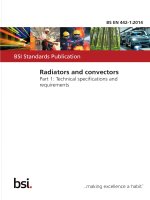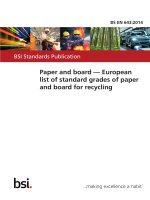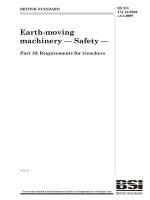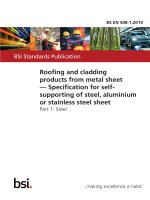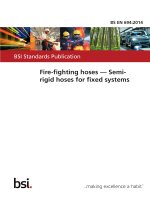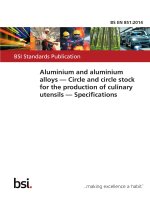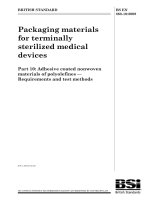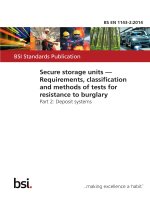Bsi bs en 16602 20 10 2014
Bạn đang xem bản rút gọn của tài liệu. Xem và tải ngay bản đầy đủ của tài liệu tại đây (1.1 MB, 38 trang )
BS EN 16602-20-10:2014
BSI Standards Publication
Space product assurance —
Off-the-shelf items utilization
in space systems
BS EN 16602-20-10:2014
BRITISH STANDARD
National foreword
This British Standard is the UK implementation of EN
16602-20-10:2014.
The UK participation in its preparation was entrusted to Technical
Committee ACE/68, Space systems and operations.
A list of organizations represented on this committee can be
obtained on request to its secretary.
This publication does not purport to include all the necessary
provisions of a contract. Users are responsible for its correct
application.
© The British Standards Institution 2014. Published by BSI Standards
Limited 2014
ISBN 978 0 580 84237 5
ICS 49.140
Compliance with a British Standard cannot confer immunity from
legal obligations.
This British Standard was published under the authority of the
Standards Policy and Strategy Committee on 30 September 2014.
Amendments issued since publication
Date
Text affected
BS EN 16602-20-10:2014
EN 16602-20-10
EUROPEAN STANDARD
NORME EUROPÉENNE
EUROPÄISCHE NORM
September 2014
ICS 49.140
English version
Space product assurance - Off-the-shelf items utilization in
space systems
Assurance produit des projets spatiaux - Utilisation
d'éléments sur étagères dans les systemes spatiaux
Raumfahrtproduktsicherung - Nutzung von off-the-shelf
Produkten in Raumfahrtsystemen
This European Standard was approved by CEN on 6 March 2014.
CEN and CENELEC members are bound to comply with the CEN/CENELEC Internal Regulations which stipulate the conditions for giving
this European Standard the status of a national standard without any alteration. Up-to-date lists and bibliographical references concerning
such national standards may be obtained on application to the CEN-CENELEC Management Centre or to any CEN and CENELEC
member.
This European Standard exists in three official versions (English, French, German). A version in any other language made by translation
under the responsibility of a CEN and CENELEC member into its own language and notified to the CEN-CENELEC Management Centre
has the same status as the official versions.
CEN and CENELEC members are the national standards bodies and national electrotechnical committees of Austria, Belgium, Bulgaria,
Croatia, Cyprus, Czech Republic, Denmark, Estonia, Finland, Former Yugoslav Republic of Macedonia, France, Germany, Greece,
Hungary, Iceland, Ireland, Italy, Latvia, Lithuania, Luxembourg, Malta, Netherlands, Norway, Poland, Portugal, Romania, Slovakia,
Slovenia, Spain, Sweden, Switzerland, Turkey and United Kingdom.
CEN-CENELEC Management Centre:
Avenue Marnix 17, B-1000 Brussels
© 2014 CEN/CENELEC All rights of exploitation in any form and by any means reserved
worldwide for CEN national Members and for CENELEC
Members.
Ref. No. EN 16602-20-10:2014 E
BS EN 16602-20-10:2014
EN 16602-20-10:2014 (E)
Table of contents
Foreword .................................................................................................................... 4
1 Scope ....................................................................................................................... 5
2 Normative references ............................................................................................. 6
3 Terms, definitions and abbreviated terms............................................................ 7
3.1
Terms from other standards......................................................................................7
3.2
Terms specific to the present standard .....................................................................7
3.3
Abbreviated terms.....................................................................................................7
4 Principles ................................................................................................................ 9
4.1
Structure and organization of OTS item selection process ........................................ 9
4.1.1
Market investigation and OTS items identification ....................................... 9
4.1.2
OTS item characterization and selection .....................................................9
4.1.3
OTS item procurement and qualification ................................................... 10
5 Requirements........................................................................................................ 12
5.1
5.2
5.3
5.4
2
Documentation .......................................................................................................12
5.1.1
OTS plan...................................................................................................12
5.1.2
Equipment specification ............................................................................ 12
5.1.3
OTS item evaluation dossier ..................................................................... 12
Market investigation and OTS item identification .................................................... 13
5.2.1
OTS item identification .............................................................................. 13
5.2.2
Preliminary Make-or-Buy decision point .................................................... 14
OTS characterization ..............................................................................................15
5.3.1
General .....................................................................................................15
5.3.2
Product assurance evaluation for OTS item characterization .................... 16
Performance evaluation - Engineering related activities .......................................... 20
5.4.1
Structural and mechanical evaluation ........................................................ 20
5.4.2
Thermal evaluation.................................................................................... 20
5.4.3
Electrical ...................................................................................................21
5.4.4
Maintenance .............................................................................................23
BS EN 16602-20-10:2014
EN 16602-20-10:2014 (E)
5.5
Final Make or Buy Decision ....................................................................................23
5.6
OTS item procurement and qualification ................................................................. 23
5.6.1
OTS item procurement ..............................................................................23
5.6.2
Qualification ..............................................................................................24
Annex A (normative) OTS plan - DRD .................................................................... 25
Annex B (normative) OTS item evaluation dossier - DRD.................................... 27
Annex C (informative) ECSS-DRD Informational Reference ................................ 33
Bibliography............................................................................................................. 34
Figures
Figure 4-1: OTS items selection process flow....................................................................... 11
Figure B-1 : Example of an OTS item status evaluation matrix ............................................. 30
Figure B-2 : Example of an comparison of existing OTS item qualification vs project
requirements ......................................................................................................31
Figure B-3 : Example of OTS item dedicated data summary ................................................ 32
3
BS EN 16602-20-10:2014
EN 16602-20-10:2014 (E)
Foreword
This document (EN 16602-20-10:2014) has been prepared by Technical
Committee CEN/CLC/TC 5 “Space”, the secretariat of which is held by DIN.
This standard (EN 16602-20-10:2014) originates from ECSS-Q-ST-20-10C.
This European Standard shall be given the status of a national standard, either
by publication of an identical text or by endorsement, at the latest by March
2015, and conflicting national standards shall be withdrawn at the latest by
March 2015.
Attention is drawn to the possibility that some of the elements of this document
may be the subject of patent rights. CEN [and/or CENELEC] shall not be held
responsible for identifying any or all such patent rights.
This document has been prepared under a mandate given to CEN by the
European Commission and the European Free Trade Association.
This document has been developed to cover specifically space systems and has
therefore precedence over any EN covering the same scope but with a wider
domain of applicability (e.g. : aerospace).
According to the CEN-CENELEC Internal Regulations, the national standards
organizations of the following countries are bound to implement this European
Standard: Austria, Belgium, Bulgaria, Croatia, Cyprus, Czech Republic,
Denmark, Estonia, Finland, Former Yugoslav Republic of Macedonia, France,
Germany, Greece, Hungary, Iceland, Ireland, Italy, Latvia, Lithuania,
Luxembourg, Malta, Netherlands, Norway, Poland, Portugal, Romania,
Slovakia, Slovenia, Spain, Sweden, Switzerland, Turkey and the United
Kingdom.
4
BS EN 16602-20-10:2014
EN 16602-20-10:2014 (E)
1
Scope
This Standard applies to all parties involved at all levels in the utilization of
OTS items into space segment hardware and launchers.
For the purpose of this Standard, Off-the-Shelf (OTS) Items are those that, even
if not necessarily developed for space applications, can be procured from the
market and utilized in a space system.
This Standard contains the requirements for the utilization of OTS Items, in
terms of their selection, characterization and procurement for space system use.
This Standard considers complex OTS items, as for example: motherboards,
cards, data storage units/items, optical equipments, photo cameras and video
units, LANs, mechanical/electrical and electromechanical devices, batteries,
sensors, monitoring support units, medical equipments and items, laptops.
This Standard does not cover:
•
software OTS,
•
re-use of OTS items already qualified for space applications,
NOTE
•
However, items not belonging to the same lot
of the OTS item already evaluated using this
standard, can be subjected to partial reevaluation and re-qualification since, on the
commercial market, fast evolution of the design
occurs.
Pieces, parts and materials, such as electrical, electronic and
electromechanical (EEE) parts, thermocouples, rivets, fasteners,
connectors, fittings, adhesives, insulation, wiring and plumbing.
This standard is not specifically addressing the re-use of OTS items for the same
space application for which they were initially qualified.
This standard may be tailored for the specific characteristic and constrains of a
space project in conformance with ECSS-S-ST-00.
5
BS EN 16602-20-10:2014
EN 16602-20-10:2014 (E)
2
Normative references
The following normative documents contain provisions which, through
reference in this text, constitute provisions of this ECSS Standard. For dated
references, subsequent amendments to, or revision of any of these publications
do not apply. However, parties to agreements based on this ECSS Standard are
encouraged to investigate the possibility of applying the more recent editions of
the normative documents indicated below. For undated references, the latest
edition of the publication referred to applies.
EN reference
Reference in text
Title
EN 16601-00-01
ECSS-S-ST-00-01
ECSS System - Glossary of terms
EN 16603-10
ECSS-E-ST-10
Space engineering - System engineering general
requirements
EN 16603-10-02
ECSS-E-ST-10-02
Space engineering - Verification
EN 16603-10-12
ECSS-E-ST-10-12
Space engineering - Methods for the calculation of
radiation received and its effects, and a policy for
design margins
EN 16603-20
ECSS-E-ST-20
Space engineering - Electrical and electronic
EN 16603-31
ECSS-E-ST-31
Space engineering - Thermal control general
requirements
EN 16603-32
ECSS-E-ST-32
Space engineering - Structural general requirements
EN 16603-50-05
ECSS-E-ST-50-05
Space engineering - Radio frequency and modulation
EN 16603-50-14
ECSS-E-ST-50-14
Space engineering - Spacecraft discrete interfaces
EN 16602-20
ECSS-Q-ST-20
Space product assurance - Quality assurance
EN 16602-60
ECSS-Q-ST-60
Space product assurance - Electrical, electronic and
electromechanical (EEE) components
EN 16602-70
ECSS-Q-ST-70
Space product assurance - Materials, mechanical parts
and processes
EN 16602-70-28
ECSS-Q-ST-70-28
Space product assurance - Repair and modification of
printed circuit board assemblies for space use
6
BS EN 16602-20-10:2014
EN 16602-20-10:2014 (E)
3
Terms, definitions and abbreviated terms
3.1
Terms from other standards
For the purpose of this Standard, the terms and definitions from ECSS-S-ST-00-01
apply.
3.2
Terms specific to the present standard
3.2.1
manufacturer
industrial subject that has developed and produced the OTS item and makes it
available on the market
3.3
Abbreviated terms
For the purpose of this Standard, the abbreviated terms from ECSS-S-ST-00-01
and the following apply:
Abbreviation
Meaning
CIDL
configuration item data list
CoC
certificate of conformance
DML
declared material list
DPL
declared process list
DRD
document requirements definition
EEE
electronic, electrical, electromechanical
EMC
electromagnetic compatibility
EMI
electromagnetic interference
ESD
electrostatic discharge
EQSR
equipment qualification status review
FMEA
failure modes effects analysis
FMECA
failure modes effects and criticality analysis
ISO
International Organization for Standardization
7
BS EN 16602-20-10:2014
EN 16602-20-10:2014 (E)
8
Abbreviation
Meaning
ITAR
International Traffic in Arms Regulation
LCC
life cycle cost
LET
linear energy transfer
LU
latch up
MTTF
mean time to failure
NIEL
non-ionising energy loss
OTS
off-the-shelf
PAD
part approval documents
PDR
preliminary design review
PCB
printed circuit board
QSL
qualification status list
RAM
reliability, availability, maintainability
RFD
request for deviation
RFW
request for waiver
SEE
single level effect
SEU
single event upset
SRR
system requirements review
STD
standard
TID
total ionising dose
VCD
verification control document
BS EN 16602-20-10:2014
EN 16602-20-10:2014 (E)
4
Principles
4.1
Structure and organization of OTS item selection
process
4.1.1
Market investigation and OTS items
identification
When a supplier decides upon the possibility of using OTS items, it is necessary
that from the very beginning a preliminary equipment specification be issued.
In parallel to this an OTS Plan is prepared.
At this point, the relevant market survey can be started.
For each OTS item candidate an evaluation dossier is initiated and all these OTS
item candidates are compared to the project requirements in order to have a
preliminary make or buy decision.
As an input to the System SRR, a preliminary OTS make/buy decision milestone
identifies a restricted number (maximum three) of OTS item candidates for
which the buy approach is viable. Refer to Figure 4-1 first sector.
NOTE
4.1.2
The liability for introducing an OTS Item into
the Project remains always with the design
authority which is in charge of the make-or-buy
decision.
OTS item characterization and selection
After the System SRR, the updated equipment specification and OTS Plan is
used as input to the characterization of each OTS item candidate.
During the characterization the OTS item candidates are deeply investigated in
order to assess their performance and qualification status and to identify any
possible modification to be introduced in the OTS item or in the system hosting
it and any delta qualification activity.
The OTS item evaluation dossiers are incrementally updated to reflect the
results of these investigations; at the end the best suitable OTS item candidate is
selected, and all related modifications and delta qualification activities are
identified thus confirming that the OTS item is qualifiable.
The OTS item evaluation dossier of the selected candidate, together with the
equipment specification and the OTS Plan, both updated for PDR, are used to
support the final make-or-buy decision milestone at the System PDR.
Refer to Figure 4-1 second sector.
9
BS EN 16602-20-10:2014
EN 16602-20-10:2014 (E)
4.1.3
OTS item procurement and qualification
After the final make-or-buy decision milestone at the System PDR, if the “Buy“
decision has been taken, the procurement activities can start.
Since this ECSS is not dealing with the simple re-procurement of already space
qualified OTS Items, two options for procurement can be envisaged:
•
OTS Items for qualification and OTS Items for flight are procured at
different times;
•
Both OTS Items for qualification and for flight are procured at the same
time.
The supplier selects which option is the best based on the relevant Project
programmatic needs.
Regardless of the procurement option selected, the Supplier then performs the
necessary qualification and acceptance related activities as per the Project
applicable requirements, detailed inside the OTS plan and the equipment
specification.
The qualification phase ends when the selected OTS Item has reached the
Qualification status requested by the Project.
The output of this phase is the completed OTS Item Evaluation Dossier that is
used to support the OTS Item Qualification status assessment.
Procurement of flight units, when the flight hardware is procured separately
from the one used for qualification, is then initiated.
10
EN 16602-20-10:2014 (E)
System PDR
System SRR
Equipment
specification
Equipment
specification
1 OTS
Item is
selected
Final
Candidate
OTS
selection
Review
OTS Items Evaluation
Dossiers Updating (1 dossier
for each OTS candidate)
OTS plan
Equipment specification
baseline
OTS Items identification and
evaluation dossiers initiation
Update OTS plan
OTS Preliminary plan
Preliminary equipment specification
Supplier submit the OTS Plan
Make
Project timeline
OTS Eval Doss 1
Make
OTS Eval Doss 2
OTS Eval Doss 3
Market
Investigation
&
Identification/
Selection of the
OTS Items
Trade offs on OTS
candidates for
characterization
Preliminary
Make/Buy
Decision
milestone
OTS Eval Doss n
OTS Buy
Option
Supplier
select
OTS
candidates
Max #3
candidates
OTS-1
Eval Dossier
OTS-2
Eval Dossier
OTS Items Characterization Phase
OTS-3
Eval Dossier
Market Investigation and OTS Items Identification
The
Supplier
choose the
Final OTS
Item and
complete
the
evaluation
for the final
Make-orBuy
decision
1 final OTS
+ its
OTS Eval
Dossier
Selected
OTS Make/Buy
Decision
milestone
Buy
OTS Item
Procurement
and
qualification
OTS Items Characterization
+
Decision Phase (phase in which to decide if using an OTS Item or Make a new Item)
Figure 4-1: OTS items selection process flow
11
BS EN 16602-20-10:2014
EN 16602-20-10:2014 (E)
5
Requirements
5.1
Documentation
5.1.1
a.
OTS plan
A dedicated OTS plan shall be established in conformance with the DRD
in Annex A.
NOTE
b.
The supplier shall submit an OTS plan with the proposal, but not later
than the system SRR.
c.
The OTS item review selection process shall be synchronized with project
review planning as per Figure 4-1.
5.1.2
Equipment specification
a.
The supplier shall generate and maintain an equipment specification
with clear allocation of requirements for the OTS item and submit it for
approval to the customer.
b.
The supplier shall submit the preliminary equipment specification at the
beginning of the OTS item identification phase and deliver it to the
customer for review at system SRR.
c.
The preliminary equipment specification shall be used as a technical
reference for the market investigation and OTS item identification.
d.
The equipment specification shall be formalized after SRR and shall be
used during the OTS item characterization and selection.
e.
The PDR issue of the equipment specification shall be used as an input to
the final make-or-buy decision.
5.1.3
a.
12
The OTS plan describes the OTS item process
selection, characterization and qualification
activities in accordance with the contents of this
ECSS Standard. The contents is specified in the
annex DRD.
OTS item evaluation dossier
For each OTS item candidate, an OTS item evaluation dossier, in
conformance with the DRD in Annex B, shall be established during the
market investigation and OTS Item identification.
BS EN 16602-20-10:2014
EN 16602-20-10:2014 (E)
5.2
b.
The OTS item evaluation dossiers shall be used to support the trade-off
decision leading to the first preliminary Make/Buy decision point prior to
SRR.
c.
The OTS item evaluation dossiers of the remaining candidates shall be
used to support the OTS items characterization and selection up to the
final Make/Buy decision point at the system PDR.
d.
After the Buy decision has been taken, the evaluation dossier of the
selected OTS item shall be maintained and updated to include all the
results of the qualification phase.
Market investigation and OTS item identification
5.2.1
OTS item identification
5.2.1.1
Market investigation
a.
In order to evaluate the possible use of OTS item the supplier shall
investigate the existence of products already successfully qualified in
similar application.
b.
If as result of project investigation specified in 5.2.1.1a, no space qualified
products are found, and the intention to use OTS Items is confirmed, the
supplier shall extend the market survey to high quality and reliability
products, to narrow down the selection of candidate OTS items to
qualified manufactures and traceable production processes.
NOTE
5.2.1.2
Exampled of high quality and reliability
products are, for instance, aeronautics, military,
and nuclear.
OTS item criticality
a.
The supplier shall identify if the OTS item is proposed for use in a safety
or mission critical function.
b.
The supplier shall identify any potential criticality involved with the use
of the OTS item.
5.2.1.3
a.
OTS item data collection
The supplier shall exclude a priori any OTS item whose performance has
been previously reported as non-satisfactory.
NOTE
When the OTS item is still affected by an active
alert or equivalent industrial practices.
b.
The supplier shall propose an OTS item which is designed for aerospace
or military application in preference to an OTS item which is not.
c.
The supplier shall identify any deviation of OTS item candidates from the
equipment specification requirements.
d.
The supplier shall identify all the OTS item functions which can lead to
negative effects.
13
BS EN 16602-20-10:2014
EN 16602-20-10:2014 (E)
e.
The supplier shall verify with the OTS item manufacturer the design
margins, and prefer those determined by test.
f.
The supplier shall gather all the available qualification data of the OTS
item candidates.
g.
The supplier shall collect all the available data relevant to the
manufacturer in order to evaluate its experience, position and stability in
the business, and OTS item commercial business practices, strategies in
development, maintenance, distribution of updates, availability of spares,
willingness to co-operate with the supplier.
h.
The supplier shall collect all the information to allow the rough
estimation of the OTS item cost, taking into account all aspects.
5.2.2
Preliminary Make-or-Buy decision point
5.2.2.1
Market investigation output
a.
Based on the data collected during the market investigation the supplier
shall decide, prior to the system SRR, if to propose a “buy” approach on
the basis of the existence of viable OTS items in a minimum number of
two.
b.
When several viable OTS item candidates exist, the supplier shall
perform a trade-off activity to reduce their number to a maximum of
three.
5.2.2.2
a.
14
Trade-off
The trade-off activities shall be based as a minimum on the following
criteria:
1.
OTS item ability to provide the required capabilities and
performances and to cope with the system design constraints;
2.
OTS item compliance with the PA and Safety applicable project
requirements;
3.
OTS item compliance versus the function criticality at system level;
4.
OTS item testability;
5.
OTS item compliance with the interface requirements;
6.
OTS item ability to be procured and used without special
restrictions;
7.
ITAR, exportability, and copyright;
8.
Short and long term cost impacts of using the OTS item;
9.
Technical, cost and schedule risks in using the OTS item;
10.
Availability of OTS item certification documentation;
11.
Proper tracking of configuration changes;
12.
Manufacturer experience, position and stability in the business,
willingness to cooperate, possibility to place contractual
BS EN 16602-20-10:2014
EN 16602-20-10:2014 (E)
arrangement for supporting the system development and
maintenance phase;
13.
Manufacturer quality system;
NOTE
14.
Obsolescence possibilities and back-up solutions;
15.
OTS item life cycle support.
NOTE
5.3
For example: The OTS item manufacturer can
demonstrate a track record for production,
Quality control procedures are established.
For
example:
Availability
of
spares,
refurbishment possibilities, service experience
supporting the successful operation of the OTS
item, Repair capability.
OTS characterization
5.3.1
General
a.
The supplier shall perform the OTS item characterization activity with
respect to the equipment specification ensuring that all the requirements
are met.
b.
In the frame of the OTS item characterization of requirement 5.3.1a, the
supplier shall collect in the evaluation dossier the following:
1.
available users documentation;
2.
manufacturer data sheet derived requirements and their validation
and verification;
3.
available qualification status versus preliminary equipment
specification;
4.
available test data;
5.
existing anomalies, non conformance reports and problem reports;
6.
potential evolutions;
NOTE
7.
For
example:
modifications.
Future
manufacturer
results of the PA activities evaluation as per clause 5.3.2.
c.
The supplier shall evaluate and agree the system architecture
modifications that allow the usage of the OTS items minimizing the need
of OTS item modification.
d.
The output of the OTS item characterization phase shall be the make-orbuy decision.
15
BS EN 16602-20-10:2014
EN 16602-20-10:2014 (E)
5.3.2
Product assurance evaluation for OTS item
characterization
5.3.2.1
Dependability
5.3.2.1.1
Criticality
a.
The supplier shall verify the system level RAM analyses to identify if the
OTS item is used in critical functions and request customer approval for
its application.
b.
The supplier shall assess the dependability criticality of the OTS item on
the basis of the specific application.
NOTE
c.
The supplier shall identify the dependability technical risks in satisfying
dependability requirements.
5.3.2.1.2
a.
FMEA / FMECA
The supplier shall analyse the OTS item in the FMECA as a black box.
NOTE
b.
This in order to assess functions and interfaces
criticalities versus the system requirements.
The supplier shall get the analysis from the manufacturer when available
or consult the available analysis or design files at manufacturer site.
5.3.2.1.3
Item monitors
a.
The supplier shall collect the information from manufacturer on the OTS
item monitoring status.
b.
The supplier shall provide dedicated interfaces towards the OTS item via
ad-hoc data interface unit.
c.
The supplier shall co-ordinate with the first level supplier the
compensations for the missing monitoring.
5.3.2.1.4
OTS item operability
a.
The supplier shall verify capability to control the item in all operational
conditions to prevent failures and hazards.
b.
The supplier shall verify the capability to switch-off the item in all
conditions, considering also the case of internal item battery provision.
c.
The supplier shall verify compatibility of OTS item warm-up time with
respect to system performances.
5.3.2.1.5
16
For example (in order of increasing criticality):
Experiments or payload; satellites; manned
modules; launchers; re-entry vehicles.
Installation and maintenance
a.
The supplier shall identify OTS item maintenance requirements.
b.
The supplier shall identify provision of installation and maintenance
features to prevent failure.
BS EN 16602-20-10:2014
EN 16602-20-10:2014 (E)
c.
The supplier shall verify the possibility that the manufacturer can
provide spares throughout the project duration.
5.3.2.1.6
Internal redundancy / design for minimum risk
a.
When evaluating the OTS item internal redundancy, the supplier shall
ensure that the project failure tolerance requirements are complied with.
b.
The supplier shall not use internally redundant OTS items without the
availability of the following information:
c.
1.
the reliability history;
2.
OTS item internal redundancy management and architecture.
The supplier shall provide all the missing information on the internal
redundancy and design to minimum risk on the OTS item.
NOTE
5.3.2.1.7
a.
For example: X-ray, NDI inspections, proof test,
and functional test.
Reliability figure
The supplier shall provide an OTS item reliability figure to support
system-level reliability assessments or engineering trade-offs.
NOTE
If the reliability figure is not provided by the
manufacturer, it can be obtained e.g. by the
following means:
• Search for data from
previous use;
experience from
• Assess data credibility via manufacturer
interview and OTS item evaluation;
• Independent expert judgement;
• Assess OTS item reliability via prediction;
• Assess OTS item reliability via similarity;
• Perform prediction (part count) when item
EEE part list is available.
5.3.2.1.8
a.
Life
The supplier shall ask the existing field data that justify the operational
life claimed by the manufacturer.
NOTE
For example: Market feedback for the products,
worst case analysis, possibility to get the
internal parts activation energy characteristics
and operating temperature.
b.
The supplier shall assess life data credibility via manufacturer interview
and item evaluation.
c.
The supplier shall assess the need for performing a life test at item level.
d.
For requirements 5.3.2.1.8a. to c. the customer approval is required.
17
BS EN 16602-20-10:2014
EN 16602-20-10:2014 (E)
5.3.2.1.9
Derating
a.
The supplier shall get data on the actual OTS item derating factors and
on its proven heritage, and assess if OTS item derating is critical with
respect to the mission requirements.
b.
In case requirement 5.3.2.1.9a. cannot be met, the supplier shall perform
analysis and test on the item.
NOTE
5.3.2.2
Safety
5.3.2.2.1
Safety criticality
a.
The OTS item shall conform to the safety requirements of the function in
which it is used.
b.
For safety critical applications any OTS internal redundancy shall not be
considered
5.3.2.2.2
a.
OTS safety data
The supplier shall provide safety data containing information on used
materials, mechanical parts, electrical components, and in general all the
information necessary to perform the safety analysis.
NOTE
Electrical components include internal energy
sources like batteries, shatterable materials.
b.
The supplier shall, for manned modules, ensure compatibility between
pressure differential and fire control requirements for all those cases
where depressurization is a fire control method.
c.
The supplier shall, in case information cannot be obtained from the
manufacturer, perform the necessary verification activities.
NOTE
18
The use of board thermography is to get a
rough estimation of thermal margin on the
most critical components also via identification
of temperature hot spots, generate thermal
model of PCB and provide simulations.
For example: X-Ray, NDI inspections, and
proof test.
5.3.2.3
EEE parts (inside OTS item)
5.3.2.3.1
EEE parts management
a.
Preference shall be given to OTS item candidates for which the employed
EEE parts are known.
b.
The supplier shall, in case of part list provision, assess the information
provided for each EEE part.
c.
The supplier shall perform inspection on OTS item to evaluate confidence
on provided part list or, if no list is provided, identify constituent EEE
parts.
BS EN 16602-20-10:2014
EN 16602-20-10:2014 (E)
d.
The supplier shall perform analysis or a test campaign to assess the
compliance of the whole OTS item with project requirements.
NOTE
For example: Total dose radiation test.
e.
Evaluate the EEE parts with regards to the environmental conditions like
temperature, radiation and vacuum.
f.
The supplier shall perform PCB inspection to identify used parts.
g.
The supplier shall perform in-depth inspection to acquire the information
necessary to complete the OTS item dossier.
h.
The supplier shall decide on risk reduction measures in order to solve the
EEE parts potential issues.
NOTE
5.3.2.3.2
a.
Part quality
The supplier shall assess part purchase policy applied by the OTS item
manufacturer.
NOTE
b.
For example: PCB coating, item segregation,
exchange of parts, exchange of connectors and
harness, introduction of epoxy adhesive for
massive components of the PCB to allow the
item surviving the acceleration and vibration
test conditions.
Part quality level, multiple suppliers for each
part type, part incoming inspection, burn in
data, and mechanical tests.
The supplier shall assess manufacturer part handling approach.
NOTE
Storage and transport control, control of
assembly process versus standard as function
of part type characteristics, e.g. plastic parts).
c.
The supplier shall procure OTS items from a recognized source, either
directly from the manufacturer of the item or from an authorized
procurer of the manufacturer of the item.
d.
The supplier shall be able to track the supply chain back to the
manufacturer of the OTS item.
5.3.2.4
Mechanical parts, materials and processes
5.3.2.4.1
Mechanical parts and materials management
a.
The supplier shall perform inspection on OTS item.
NOTE
b.
This inspection aims at improving confidence
on provided part list and when no list is
provided to identify constituent materials and
mechanical parts.
The supplier shall perform an analytical assessment or a test campaign to
assess the whole item compliance with project requirements.
19
BS EN 16602-20-10:2014
EN 16602-20-10:2014 (E)
NOTE
c.
5.3.2.4.2
and
For example: Item segregation, exchange of
parts if materials are non-compliant, conformal
coating or potting of the PCBs with nonflammable compound, exchange of housing,
exchange of specific flammable parts.
Prohibited materials
a.
The supplier shall perform OTS item inspection to identify the presence
of any prohibited materials.
b.
The supplier shall perform lab inspection.
NOTE
c.
For example: Chemical,
gassing, flammability.
off-gassing,
out-
The supplier shall decide on risk reduction measures in order to solve the
prohibited material issue and request customer approval.
Performance evaluation - Engineering related
activities
5.4.1
Structural and mechanical evaluation
a.
The supplier shall verify that the OTS item is able to operate in the
mechanical environment of the specific application.
b.
The supplier shall verify that the OTS item does not generate any
detrimental mechanical effect within the operational environment.
c.
The supplier shall identify that the modifications to be performed on the
OTS item, in order to cope with the anticipated mechanical environment,
are justified and their adequacy is demonstrated.
d.
The supplier shall perform verification of the structural characteristics of
the OTS item in accordance with the requirements of ECSS-E-ST-32.
5.4.2
Thermal evaluation
a.
The supplier shall verify that OTS item is able to operate in the thermal
environment of the specific application.
b.
The supplier shall verify that the OTS item thermal design is able to
withstand those environmental factors encountered during all mission
phases and take due account of any possible degradations.
NOTE
c.
20
flammability
The supplier shall decide on risk reduction measures.
NOTE
5.4
For example: Toxicity,
outgassing tests.
Causes for degradation can be e.g. wear, noncondensable gas build-up, mechanical loads,
and test environment.
The supplier shall ensure that any OTS item cooled by natural convection
system is modified to a suitable alternative cooling method.
BS EN 16602-20-10:2014
EN 16602-20-10:2014 (E)
d.
The supplier shall analyse and identify any modification to be performed
on the OTS item in order to cope with the foreseen thermal environment.
e.
The supplier shall consider the safety related requirements, like touch
temperature, flammability problems and ignition hazards, as driving
criteria for the OTS item acceptance or exclusion from the early phases of
the evaluation process.
f.
The supplier shall verify the OTS item thermal requirements in
accordance with ECSS-E-ST-31.
5.4.3
Electrical
5.4.3.1
General
a.
The supplier shall verify that the OTS item electrical design is able to
operate in accordance with the intended application.
b.
The supplier shall identify through analysis all the modifications to be
performed on the OTS item in order to cope with the required electrical
performances.
c.
All safety issues shall be considered as driving criteria for the OTS item
acceptance or exclusion from the early phases of the evaluation process.
NOTE
d.
Safety issues can be high voltages or high
electrical powers, EMC/EMI, grounding, and
radiation.
Warm-up time of the OTS items shall be verified to ensure compatibility
of the item with the system needs.
5.4.3.2
Electrical power requirements
a.
The supplier shall verify the OTS item electrical requirements in
accordance with ECSS-E-ST-20.
b.
AC/DC shall not be used in space applications.
NOTE
This constraint forces to remove or to exclude
the unit power supply and redesign it.
c.
The OTS item new power supply shall be designed and manufactured by
the supplier according to the space environment and constraints in
accordance with ECSS-E-ST-20.
d.
The OTS item, where the already available DC/DC converter input power
lines are compatible to spacecraft power bus, shall be verified or
modified by the supplier according to the space environment and
constraints as per ECSS-E-ST-20.
e.
Fuses whose performances are not in accordance with the ECSS-E-ST-20
shall be removed and replaced by the supplier with other fuses or other
appropriate devices.
f.
For OTS items where the only power source is a rechargeable or nonrechargeable battery, the supplier shall investigate the possibility to
substitute this power source by a space qualified one.
21
BS EN 16602-20-10:2014
EN 16602-20-10:2014 (E)
g.
In case a substitution of the power source, as per 5.4.3.2f., is not possible,
a DC/DC converter shall be designed by the supplier according to the
space environment and constraints of ECSS-E-ST-20.
5.4.3.3
a.
The supplier proposing the use of an OTS item Data Handling System or
of an OTS item as a part of a Data Handling System shall verify its design
requirements according to ECSS-E-ST-50-14.
b.
The supplier proposing an OTS item interfacing with a Data Handling
System shall verify its interfaces performances according to ECSS-E-ST50-14.
c.
For OTS items with non-compatible data interfaces, a dedicated interface
adapter shall be developed by the supplier, in order to ensure the
compatibility, according to ECSS-E-ST-50-14.
5.4.3.4
Radio frequency transmission and reception
a.
The supplier shall verify the OTS item RF compatibility according to
ECSS-E-ST-50-05.
b.
The supplier shall implement the modifications on the OTS item to
comply with the RF requirements of ECSS-E-ST-50-05.
5.4.3.5
Electromagnetic compatibility
a.
The supplier shall verify OTS item conformance to EMC requirements
according to ECSS-E-ST-20.
b.
For OTS items that exist in plastic cases only, the viability of upgrading
their housing to a metallic one shall be investigated and implemented by
the supplier, where feasible.
5.4.3.6
22
Data handling
High energy radiations
a.
The supplier shall verify OTS item conformance to project applicable
radiation environment.
b.
The analysis of OTS item EEE internal parts for the Total Ionizing Dose
(TID), Non-Ionising Energy Loss Fluence (NIEL) and the Single Event
Effect (SEE) due to the heavy ions and high energy protons shall be
performed by the supplier in accordance with ECSS-E-ST-10-12.
c.
The supplier shall perform a dedicated analysis to evaluate the
criticalities from Single Event Upset (SEU) and Latch Up (LU) and
provide adequate preventive or corrective actions.
d.
For OTS items not specifically characterized for space applications in
terms of radiation behaviour, a dedicated test campaign shall be
conducted by the supplier to measure the sensitivity of these equipment
in terms of at least Total Ionising Dose with Gamma rays, Single Event
Effects with Protons beams.
BS EN 16602-20-10:2014
EN 16602-20-10:2014 (E)
5.4.3.7
a.
The supplier shall identify any prohibited parts according to project
requirements and take corrective actions in accordance with ECSS-Q-ST60.
b.
Supplier shall ensure that assembled printed circuit boards are repaired
or modified according to ECSS-Q-ST-70-28.
c.
The supplier shall identify any materials, mechanical parts and processes
prohibited by project requirements and take corrective actions in
accordance with ECSS-Q-ST-70.
5.4.4
a.
5.5
5.6
EEE quality and constraints
Maintenance
The supplier shall identify any maintenance activity specific for the OTS
item.
Final Make or Buy Decision
a.
Based on the data collected and on the results achieved during the
characterization phase, the supplier shall decide if to propose the final
buy approach, not later than the system PDR.
b.
The OTS Item qualification capability shall be demonstrated by the
supplier together with conformance with the EQSR approach.
c.
At the system PDR, the supplier shall submit to the customer for
concurrence, the final OTS-Item make-or-buy decision.
OTS item procurement and qualification
5.6.1
OTS item procurement
5.6.1.1
OTS item procurement documentation
a.
The supplier shall identify the procurement document and freeze it in the
OTS item evaluation dossier.
NOTE
b.
From the data of the OTS item evaluation dossier a final OTS item report
shall be issued by the OTS item supplier and approved by the first level
supplier.
5.6.1.2
a.
A procurement document can be an OTS item
dedicated specification or the manufacturer
bulletin.
Batches
The supplier shall purchase all OTS items from a single lot.
NOTE
Single lot purchase is done to minimize the
risks deriving from OTS items developed at
different times and with differences in terms of
materials, internal parts (including EEE parts)
23


